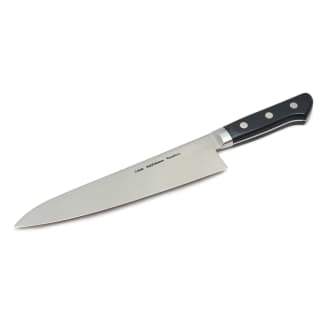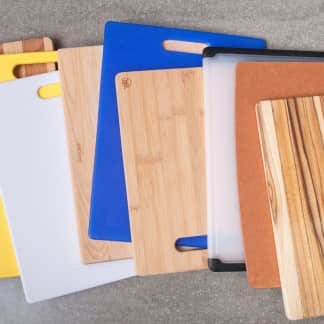A good-quality cutting board is essential. Our favorites are big, sturdy, and durable, but sometimes we like to supplement them with lighter-weight options. Enter flexible cutting mats. Lightweight and made from dishwasher-safe plastic, they can be easily tucked into the dishwasher after use—a convenience that we especially appreciate when working with messy raw proteins. They're also generally flexible enough to roll up like a newspaper and funnel ingredients directly into a skillet or bowl. We purchased eight, including products sold in packs of four or five and one that's sold individually. We put them through their paces with a slew of cutting and chopping tasks, evaluating how well they stood up to stains, odors, repeated knife strokes, and washing.
We Wanted Mats That Stay in Place
Flexible cutting mats are often double-sided, and they can be used directly on the counter or placed atop a larger cutting board. We tried them in each position. No matter how they're arranged, they're simply more prone to slipping than standard cutting boards. Some rocked back and forth or spun in circles, even when we used a damp paper towel to try to anchor them in place. Slick foods, such as halved onions and raw chicken, also sometimes slid on the mats. In this evaluation, the surfaces of the mats proved to be more important than their thickness or weight. Perfectly smooth mats tended to slip or skate around on the counter. The mats that felt most stable—both on the counter and atop a cutting board—had swirls, tiny raised dots, or grid patterns. If they were textured on only one side, we preferred to place that side on the counter for extra stability, but mats that were textured on both sides stayed put better and provided more traction for slick foods.

Are Bigger Mats Better?
We also preferred midsize mats. Some were so dinky that chicken pieces slid off as we pounded them and diced onion spilled onto the counter. But one mat was too big to be convenient; the extra space was useful for cutting, but at 18 by 24 inches, it was difficult to store and wouldn't fit in most dishwashers. The most versatile boards measured about 11 by 14 inches (the same as our winning small cutting board, from OXO), making them big enough to contain all the food we were preparing but still compact enough to easily maneuver around the kitchen and put in the dishwasher.

The Best Mats Combine Strength and Flexibility
A handy benefit of flexible cutting mats is that you can bend them to funnel ingredients into bowls and cookware, so we used the mats to ferry chopped onions, carrots, celery, and broccoli around the kitchen after cutting the vegetables on the mats. We also transferred flour to the bowl of a stand mixer, a simple task that often results in flour spilled everywhere. Mats that were too stiff and rigid could only be tilted into skillets or mixing bowls, and that was no more effective than working with traditional flat cutting boards. Truly flexible mats tidily funneled their contents precisely where we wanted them.
Here, thickness was key. The most rigid mats in our lineup were also the thickest, measuring between 2 and 3 millimeters thick, about the same as the cover of a hardback book. But thinner wasn't always better. One mat was just 0.50 millimeters thick (thinner than a credit card), so it felt flimsy and was hard to pick up from the counter. The sweet spot was between 0.77 and 1.46 millimeters. Our favorite mat, which was both flexible and strong, fell at the high end of that range.

Are Flexible Cutting Mats Durable?
Since most of these mats are inexpensive and come in packs of four or five, we don't expect them to be as durable as traditional cutting boards. Each product had visible knife marks after testing, but some showed egregious wear and tear. A few became stained or warped. The colorful trim flaked off one product, leaving behind a sticky residue. Again, the mats with textured surfaces had an advantage: Those bumps and swirls deflected and concealed knife marks, so the mats were significantly less worn.

In the end, we found a set of flexible cutting mats that we'll be glad to have on hand for quick, messy cutting tasks and to easily transfer ingredients. Dexas Heavy Duty Grippmats were the perfect size: large enough to fit a significant amount of food but not so big as to make cleaning and handling a pain. They also struck the right balance between strength and flexibility, and they're textured on both sides for better stability.
The Tests
- Portion head of broccoli into slices and florets, then transfer pieces to mixing bowl
- Cut 4 chicken breasts into thirds and pound to even thickness
- Using mat as funnel, transfer 2 cups flour to bowl of stand mixer
- Conduct additional testing with 3 testers
- Make 50 additional knife cuts using 5 pounds of pressure, then evaluate for damage
- Mince 1 clove garlic and 2 tablespoons chipotle in adobo, wait 2 hours, then wash by hand and evaluate for stains and odors
- Wash each mat 25 additional times, using dishwasher unless mat doesn't fit
- Evaluate for wear and tear
How We Rated
- Size: Mats that were oversize or too small to contain moderate amounts of food rated poorly. The best mats contained food and mess without dirtying the surrounding counter.
- Stability: We rated the mats on how securely they sat on the counter, docking points from mats that spun, slipped, or rocked significantly.
- Flexibility: The highest-ranked mats were flexible enough to funnel ingredients into skillets or bowls but didn't feel flimsy.
- Durability: We evaluated each mat on how resistant it was to knife damage.
- Cleanup: Mats fared best if they resisted stains and odors, were easy to clean, and didn't peel or warp in the dishwasher.
- Dimensions of about 11 by 14 inches
- Medium thickness, between 0.77 and 1.46 millimeters
- Lightly textured surfaces to provide stability on the counter and traction for slippery foods and to conceal knife marks
- Balance of flexibility and rigidity for transferring ingredients easily
- Resists stains, odors, and warping












